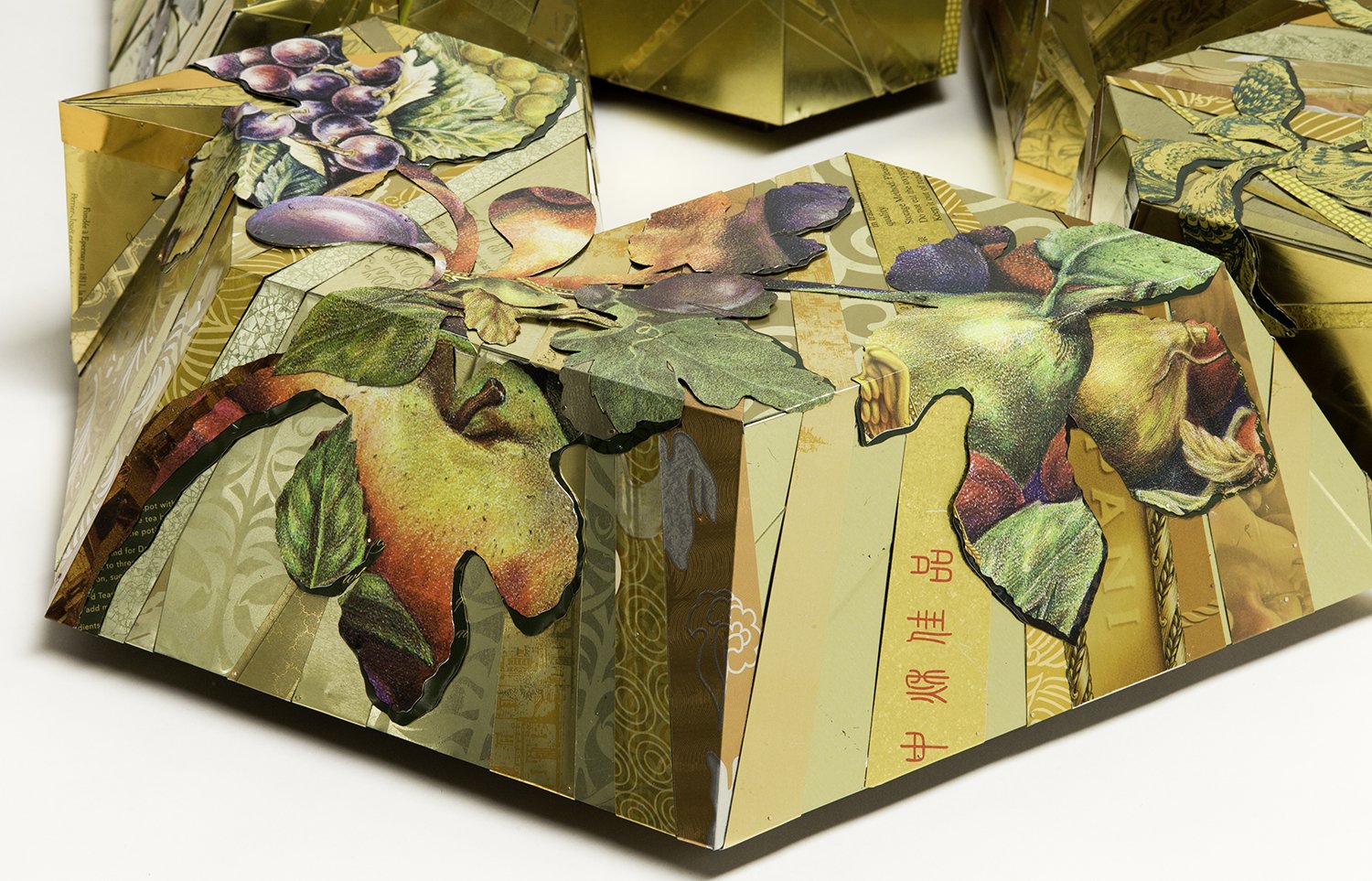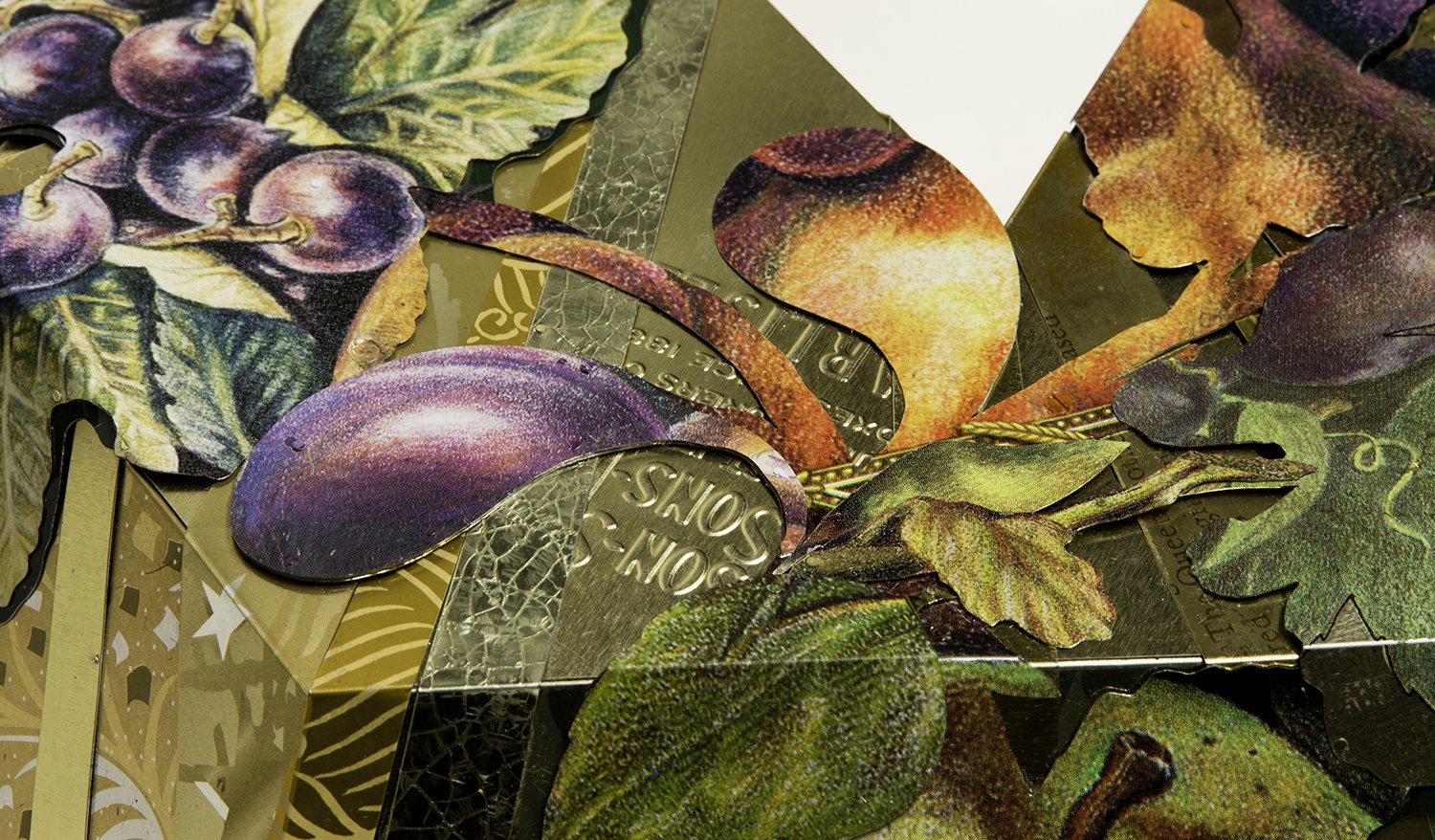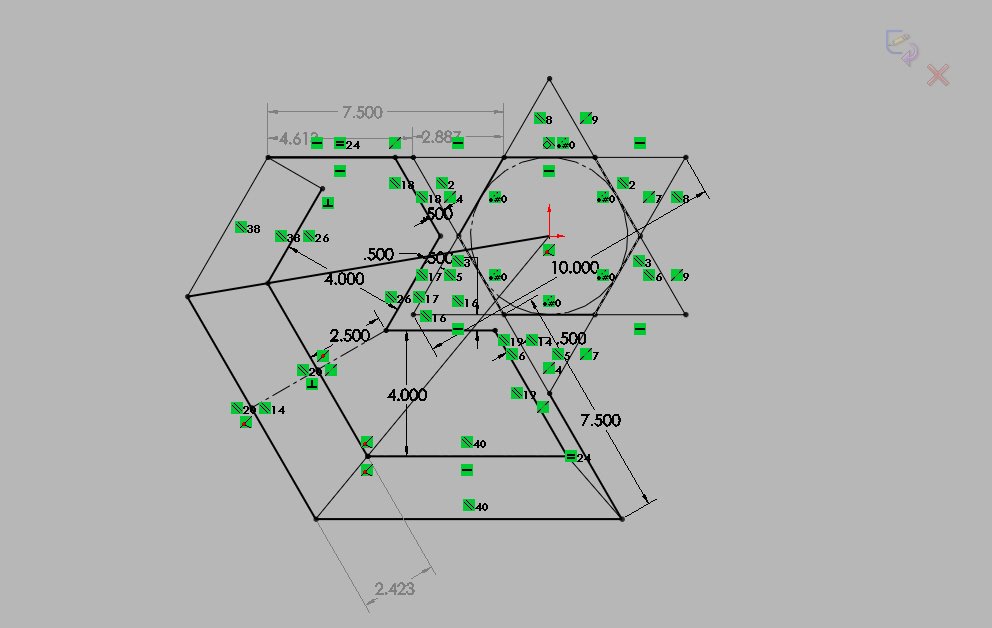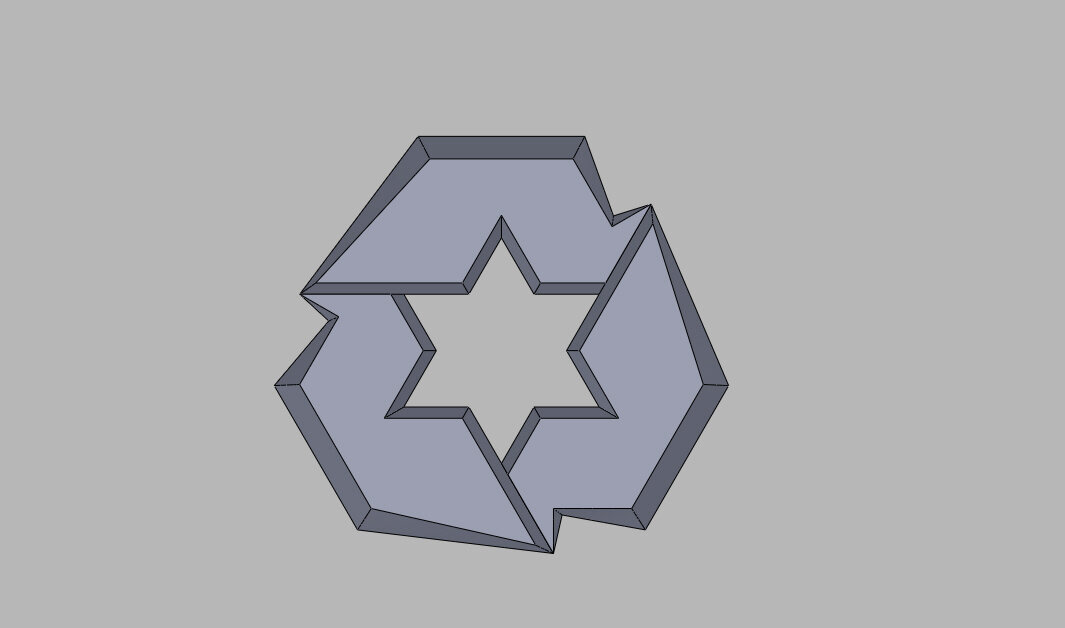Contemporary Judaica seder plate for the holiday Tu Bishvat constructed from post-consumer recycled tin cans, 10k gold rivets, sterling silver rivets, aluminum rivets, brass screws, and Plexiglas. Dimensions: 6”H x 24”W x 20"D
This piece is available for purchase or exhibition.
Since 1988, the use of post-consumer recycled materials has been a core premise of my work following the concept of "tikkun olam" or repair the world. The overall form of this Tu Bishvat seder plate is based on an interpretation of the recycling symbol.
This interpretation of the recycling symbol covered in metallic gold tin cans creates a platform for the three types of fruit mentioned during the Tu Bishvat Seder service.
The observation of Tu Bishvat talks about the three biblical categories of fruits. There’s the fruit such as pomegranate where you don’t eat the exterior of the fruit but eat only the seeds. The second category is fruit such as olives in which you eat only the exterior and not the seed. In the third category, there’s fruit where you eat every part of the fruit (seeds and all), such as figs and grapes.
The three definitions of fruit fit neatly into the idea of the three arrows of the recycling symbol.
For Assiyah, a pomegranate symbolizes the fruit where only the inside is eaten.
Looking more closely at the images, you can see that many of the images were either found printed on tin cans or created by cutting out shapes from various tin cans. The bark of the pomegranate looks brown, but on closer inspection, you can see buildings from a Venetian cookie tin. The leaves are from different green-colored tins.
For Yetzirah, olives on an olive branch represents fruits where only the outside is eaten.
For Beriyah, there are images of apples, pears, figs and grapes, fruits where all parts are eaten.
Look closely to see that within the abstracted shape of the fig leaves are images of an apple and a pear.
All the tins used to make this seder plate were post-consumer recycled tin cans. Below you can see the embossed lettering from the bottom of a tin can where it had the product identity. Again the figs are cut from tin cans.
The gold tins used for the background range from attractive metallic tins to tin can bottoms, the part that I might have recycled. Strips of tin cans were added and layered to create the appearance of radiating lines. Underneath the radiating lines of tin, (in the photo below) you can see the Pittsburgh recycle steel symbol from the bottom of a tin.
Close-up of embossed can on Reduce, Reuse, Recycle - Assiyah, Yetzirah, Beriyah Seder plate made from recycled tin cans
Back away to visualize the Star of David in the center of this three-part platform.
The center star is a symbol of Judaism subtly presented as a radiating light. You can see the center of this seder plate is a Jewish Star.
The Jewish star is as much an illusion as reality. I love how the sloping sides reflect the star motif and echo the form. If light is directed toward the center of the Seder plate it will reflect a Jewish Star on the ceiling (shown left).
In the photo below, Plexiglas panels are placed on top of the seder plate for functional use so that fruit or nuts will not be in contact with the tins. [The exhibition of this Seder plate should be without the Plexiglas as it slightly obscures the details.]
This Seder plate was included in the book Modern Judaica, Today’s Makers, Today’s Sacred Objects*.
*This is an affiliate link provided for your convenience.
Fabrication of Reduce, Reuse, Recycle, Assiyah, Yetzirah, Beriyah - a Seder plate for Tu Bishvat
If you are interested in viewing the design and fabrication of this Judaica Tu Bishvat seder plate, I have created a step-by-step photo album.
Reduce, Reuse, Recycle, Assiyah, Yetzirah, Beriyah is loosely based on the three arrows recycle symbol.
The three-dimensional shape for Reduce, Reuse, Recycle, Assiyah, Yetzirah, Beriyah was an incredibly complex form. The only way I could figure out the construction is with a CAD rendering shown below (with the help of my son and mechanical engineer, Ace Shelander. )
This complex form was then made out of recycled cereal boxes and covered with paper and Bristol Board (shown below.)
Using the paper templates as a guide, the form was constructed from recycled tin cans and covered with layers and layers of metallic tins. I used 10k gold rivets to blend with the metallic finish and add strength.
Adding layers and layers of metallic recycled tin cans take time….and more time. The humblest of materials, very often the bottom of the tin cans are just the beginning. Each strip has to be added very slowly and methodically so it fits properly.
Cutting leaves, and fruit from tin cans takes even more time. It all starts by studying the olive tree and fig tree in my backyard or walking the neighborhood to study fruit trees.
Below you can see figs and fig leaves in the backyard.
Drawings for olives and branches start from branches of the olive tree from my front yard. I drew on a paper cut-out that matched the shape of the Seder plate form.
After figuring out the sketch, I cut layers and layers of the recycled tin cans to create the complex combination of forms and images. You can see olives, figs, and pomegranates.
After cutting out the leaves and branches they are bent to fit and the riveting starts.
Leaves, branches, and olives are added and riveted into place. You can see that I use scotch tape which works really well to hold pieces in place until it is riveted.
The Biblical explanation for the selection of fruit.
For Beriyah, apples, pears, figs, and grapes represent fruit where all parts are eaten.
Explanation of Beriyah from the Hillel Seder Service:
In the third realm, Creation, the tree has grown into a full being and is blooming.
No protective shells are needed within or without. The fruit of the realm of Creation has no shell or pit and may be eaten whole. This represents the realm of intellect. Fruits of Beriyah include grapes, figs, apples, citrons, pears, quinces, and carob.
Just as a fig tree, as long as someone examines it, one will find figs, and so too with the words of Torah, as long as someone meditates on them, one will find new insights. (Babylonian Talmud Eruvin 54a-b) Since this is the realm of intellect, we will take some time to study Jewish texts about humanity's relationship to trees.
There is a verse in the Bible that compares humans to trees: "When in your war against a city you have to besiege it a long time in order to capture it, you must not destroy its trees, wielding the ax against them. You may eat of them, but you must not cut them down. Are trees of the field human to withdraw before you into the besieged city? As you will see, Biblical commentators disagree over how to read this verse."
For Assiyah, a pomegranate branch symbolizes the fruit where only the inside is eaten. Look closely to see that the leaves, fruit, and branch are all cut from various tin cans. (I love the abstraction of the branch and leaves.)
Explanation of Assiyah from Hillel TuBishVat Seder service:
The realm of Assiyah is the furthest from perfection. Symbolically, this realm requires the most protection, and therefore we eat fruits that have a shell on the outside – to protect them from the external elements. With this fruit, we have a rooted awareness of the tangible world around us, in both its natural and human dimensions. We concentrate on our proper place in that world.
For Yetzirah, an olive branch represents fruits where only the outside is eaten.
Explanation of Yetzirah from the Hillel Seder Service:
We now turn toward inner, spiritual development. The fruit of this world has no outer shell but an inner pit that we don't eat.
The pit or seed is a means of regrowth. It symbolizes the earth's reawakening and with it we can cause a transformation of raw materials. Fruits with a pit or seed include olives, dates, cherries, plums, apricots, etc.
I chose to use olives because olives grow right outside my house and it is a biblical fruit.
























